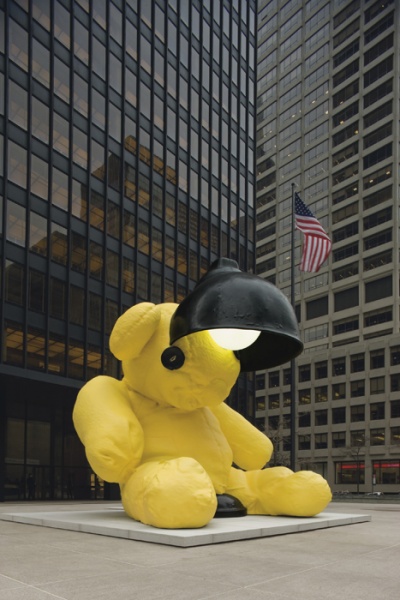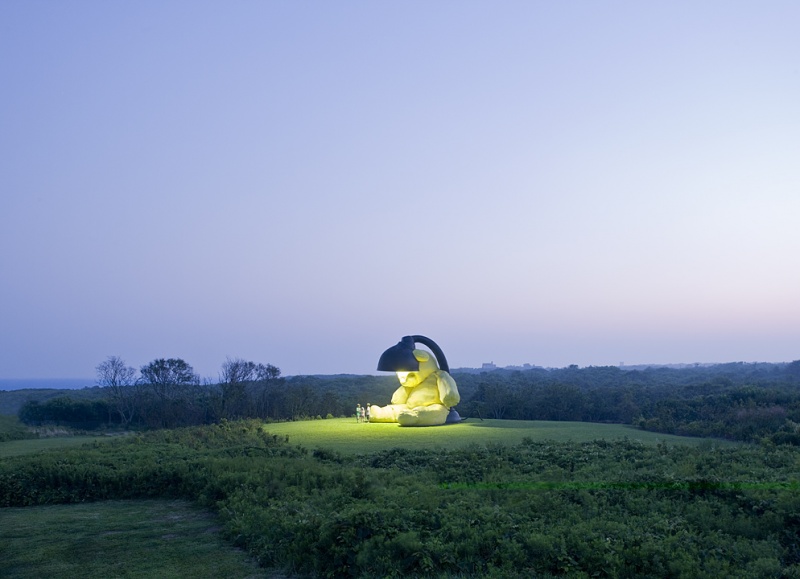Urs Fischer’s monumental bronze Untitled (Lamp/Bear) (2005–2006), will be offered for sale at Christie’s New York on May 11, estimated to sell for about $10 million. The work is installed in the plaza in front of the Seagram Building until September.
It’s a funny thing, outdoor sculpture—makes me think of kitschy Henry Moore bronzes, garish Calders rusting at the corners, a Mark di Suvero abandoned in a field; perhaps even a Sol Lewitt concrete block sculpture once white and pristine, now graying, turning slightly green.
Outdoor sculpture had been tired for a long time—and especially neglected by younger artists—before Jeff Koons brought it back with the fantastic flower Puppy (1992). That work is much more than a sculpture; it’s a topiary of giant proportions and thus requires constant maintenance, a childlike fantasy, a great mascot and symbol–a great work of art on many levels. By the time the world appreciated Puppy at the Guggenheim Museum in Bilbao and its 2000 installation in Rockefeller Center, outdoor art was ready for a comeback.

Most great art is not like Puppy; it does great things, but it doesn’t appeal to everyone. For instance, I have a soft spot for Marcel Duchamp’s In Advance of the Broken Arm (1915), which is a simple snow shovel. 99.9% of the world wouldn’t give you $20 for it. It is the most awkward and unappealing of all the readymades, and that is precisely why Duchamp selected it: because it’s so bad. By contrast, aesthetically, Puppy works for everyone, high-brow, low-brow, and everyone in the middle.
I first learned about Urs Fischer’s Bad Timing Lamb Chop (2004) in 2004. The sculpture combined a large, half-empty cigarette pack intersecting with a chair. It seemed ungainly, awkward and just plain wrong—I bought it.
And of course it seemed wrong, because this young Swiss artist was on to something new—something beyond the Technicolor Buddha of Murakami and the mirrored blobs of Kapoor. Bad Timing Lamb Chop is a work that asks questions and doesn’t provide answers. People like to ask me what it means, and I can’t provide much of an answer beyond the fact that compositionally and conceptually, it’s completely out of proportion. The cigarettes are half smoked and the chair is empty—yet somehow they find a strange and precarious equilibrium.
When two years later a dealer pitched me a new Fischer project, Untitled (Lamp/Bear), a 35,000-pound bronze teddy bear to be cast in China at a Buddha factory, it seemed like a joke. Fischer appeared both ambitious and arrogant to think he could get away with such a humongous project.
I really didn’t need one or want one, but it seemed like a risk to say “yes” and even riskier to say “no.” I felt the work would be great; it almost had to be since it was an act of complete hubris, but with the potential of real genius.
In 2007, when my wife and I settled on a house on Montauk for spending the summers, our neighbor threatened to build a house in the shape of a windmill right next door. I was really distressed by the idea, but the antidote was obvious. I’d drop the Untitled (Lamp/Bear) on the bluff just next to him. Mission accomplished and his plans were put on hold. (The economy helped.)
Admittedly, I worried that the town and the neighbors would riot, for this was a great work of art for those “in the know” but how about everyone else? Fortunately for our privacy’s sake, there is no public access. The piece is visible from the water only, which is also rather poetic since he sits alone, with no one to bother him.
Soon he got popular. The surfers were using the work as a landmark to prepare for the great wave that builds after a storm. Local fishermen were using it as a reference point to find their favorite striped bass fishing spot.

Everybody loves the bear, especially at night when its visor is illuminated and casts a soulful, introspective glow.
I once asked Urs why the bear needed to be in bronze, the most expensive and heavy material he could have chosen. He said in response, “This way, it will last forever.” Beyond iconography, the object is an equivocation on every level: it’s happy and sad; what’s small is big; what looks soft is hard; what is light is heavy; and what comes from childhood resonates within us decades later. The sculpture manages to capture the fancy and the imagination of everyone who sees it. Large successful public sculptures like this one are almost impossible to achieve. They are usually saccharine, or just plain dull.
When I first learned that one edition of the bear (it’s a set of three) was leaving Francois Pinault’s great collection, and that new owners would place the work on the market, I was disappointed. But I’m thrilled to see it on Park Avenue, sadly and gladly hunched in front of the rational perfection of Mies van der Rohe’s Seagram Building. I can only hope that his next stop will be a great public collection where he’ll get plenty more love and affection.